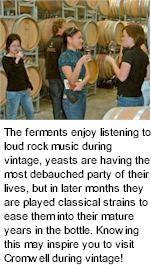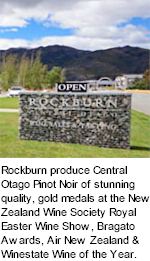


Central Otago's wine industry symbolizes success and its continental climate rivals Europe's best. The region has a long viticultural tradition. French migrant Jean Desire Feraud, who pioneered grape growing and wine production over 100 years ago, left a strong legacy. Today more than 1,000 hectares of grapes flourish in unique growing conditions. The skills of talented winemakers produce quality boutique wines to compete with the country's finest. At 45º south, Central Otago has a climate similar to Burgundy. It enjoys a semi continental climate and experiences greater daily and seasonal extremes of temperature unknown elsewhere in New Zealand. The area’s unique soil types have a marked influence on vine growth, the flavours of the grapes and ultimately the wine.

Rockburn takes its name from the rugged, rock strewn, burn scarred landscape of Central Otago. The region is renowned for its stunning scenery of rugged mountains and picturesque lakes. Rockburn's vineyards are bounded on the west by mountains on whose seaward slopes are rain forests, which receive 5000mm of rain a year. To the east is a barren, moon-Iike landscape that receives less than 25mm of rain a year. Situated between these extremes is Rockburn, produce not only Pinot Noir of stunning quality (gold medals at New Zealand Wine Society Royal Easter Wine Show, Bragato Awards, Air New Zealand, and Winestate Wine of the Year) but also medal winning Sauvignon Blanc, Chardonnay, Pinot Gris, Riesling and Gewurztraminer.
All Rockburn wines exhibit strong varietal characteristics, highlighted in the white varieties by crisp acids, which are typical of the region. It has also become apparent that like Burgundy there are distinct appellations within Central Otago. One has only to taste a Gibbston Valley Pinot Noir to experience its perfumed nose, typically violets and earthy, forest floor sensations on the palate.
Compare the effusiveness of Gibbston with a Lowburn/ Bannockburn Pinot Noir, exhibiting darker colour and fuller, sweeter fruit. Hand picked grapes from the Parkburn and Gibbston Valley Back Road Vineyards reflect Rockburn’s unique terroir. For this reason, to fully exploit the potential of the region, it is a distinct advantage to have vineyards in different appellations. The finished wines fully express the complex subtleties in New Zealand's one true continental climate.

Nevertheless, the evoving wines are encouraged to enjoy themselves. The ferments enjoy listening to loud rock music during vintage, yeasts are having the most debauched party of their lives, but in later months they are played classical strains to ease them into their mature years in the bottle. Knowing this may inspire you to visit Cromwell during vintage!
The philosophy at Rockburn is to treat the fruit and wine as gently as possible, with minimum interference and maximum ease of use, vintage workers commonly only have one hand available as the other is usually holding a beer or coffee. To this end, the destemmer is uniquely mounted above the Pinot Noir fermenters. The fruit travels up to it on a slow conveyor, allowing sorting and removal of any sub-standard fruit, leaves or earwigs, to be destemmed directly into the fermenter, minimizing damage to the whole berries and thereby retaining the delicate fruit aromas and flavours that typify great Central Otago Pinot Noir. The removed stems are collected behind the fermenter and returned to the vineyard compost pit, eventually to further enhance the organic life of our soils.
White varieties are all gently whole bunch pressed, 3 tonne at a time, reducing extraction of bitter phenolics and retaining delicate aromatics. The white juice of each variety is pumped into one or two fermentation tanks, which are all of different volumes to allow for the different tonnages of each variety. The pressed bunches are then returned to the compost pit, as are the Pinot Noir skins which are pressed once they have imparted enough colour, tannin and flavour. All fermentation tanks and the two barrel cellars, red and white, are fully temperature controlled and carefully humidified as well. Pinot Noir lives in barrel for 10 months, going through malo-lactic as it naturally warms in the spring, and is brought out and bottled shortly before (or during!) the ensuing vintage.
